September 25, 2025

The article titled "10 Essential Stimulus Control Examples for Effective ABA Therapy" serves as a crucial resource for professionals seeking to enhance the effectiveness of Applied Behavior Analysis (ABA) therapy. It provides practical examples of stimulus control techniques designed to empower learners, thereby fostering greater independence and skill retention. Key strategies discussed include:
These methods illustrate how systematic cue management can significantly improve therapeutic outcomes. As the demand for Board Certified Behavior Analysts (BCBAs) continues to rise, understanding and implementing these techniques becomes essential for effective practice.
How can you leverage these strategies to address current challenges in your ABA practice? This article not only sheds light on the importance of stimulus control but also positions itself as a vital tool for those committed to excellence in ABA therapy.
The landscape of Applied Behavior Analysis (ABA) therapy is evolving rapidly. An urgent demand for effective techniques that enhance learning and independence among clients drives this change. Board Certified Behavior Analysts (BCBAs) are striving to implement innovative strategies, making the understanding of essential stimulus control examples paramount.
How can practitioners effectively navigate the complexities of cue management to foster autonomy in learners while overcoming common challenges in the process? This article delves into ten critical stimulus control techniques, offering insights into their practical applications and the transformative impact they can have on the effectiveness of ABA therapy.
The demand for Board Certified Behavior Analysts (BCBAs) is projected to surge by 25% by 2026, highlighting an urgent need for effective recruitment strategies in the healthcare sector. Hire ABA is a specialized recruitment platform meticulously designed to streamline the job search for BCBAs. By honing in on the unique needs of these professionals, the platform adeptly connects candidates with roles that align with their skills and career aspirations. This targeted approach not only accelerates the job search process for candidates but also empowers employers to swiftly identify qualified professionals, effectively addressing the growing demand for board-certified behavior analysts in the Applied Behavior Analysis (ABA) therapy sector.
Utilizing Hire ABA can significantly enhance hiring efficiency within healthcare settings. The platform offers personalized resume assessments and advanced job fit scoring, ensuring that each candidate's experience and career goals are thoroughly evaluated. It also identifies opportunities that align with their skills, preferences, and desired locations.
Are you facing challenges in finding qualified BCBAs? Healthcare employers are encouraged to leverage these tools to optimize their recruitment strategies and effectively meet the increasing demand for BCBAs in the market. With Hire ABA, you can confidently and secure the talent necessary for success.
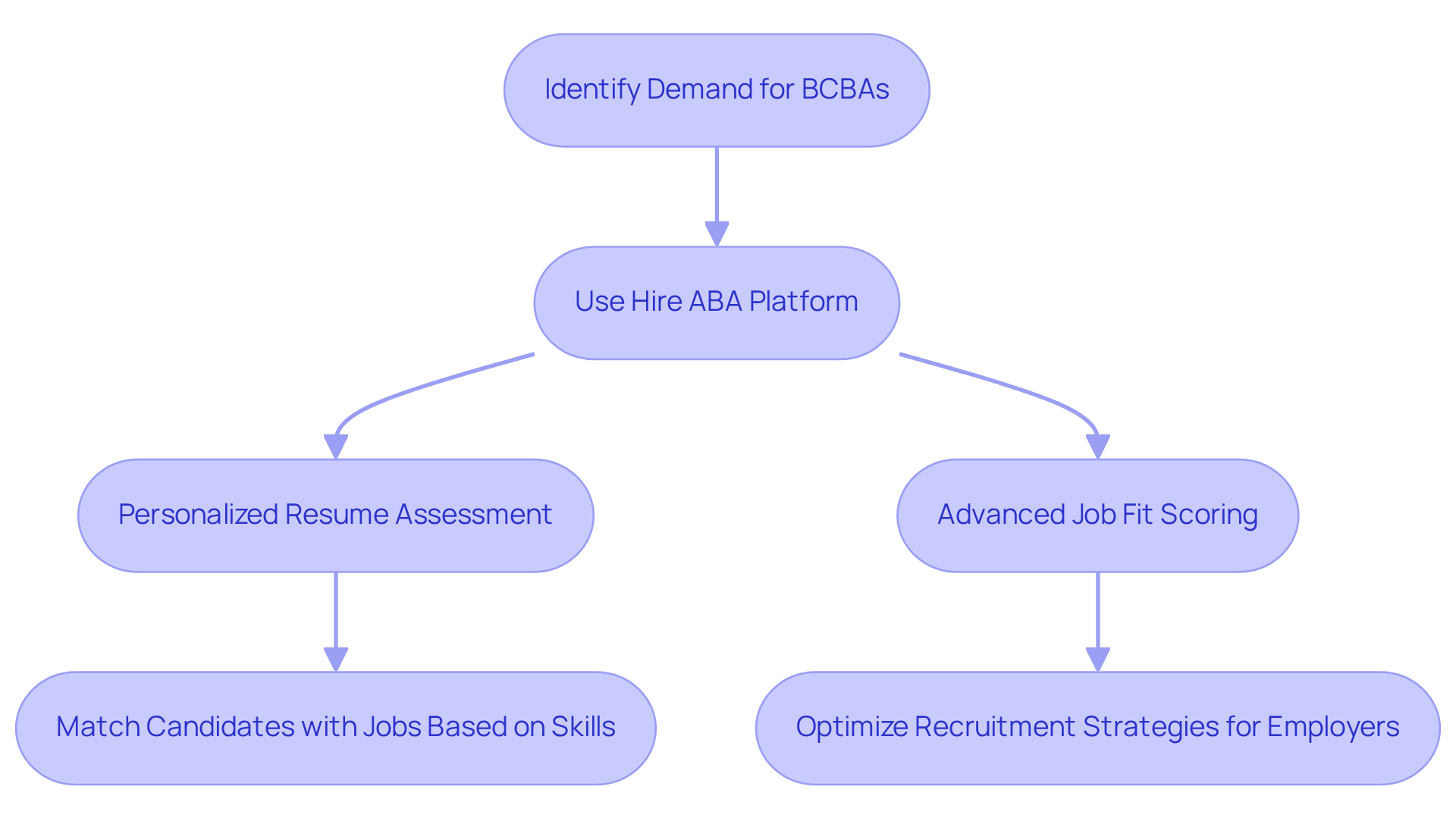
Prompt fading is an essential technique in behavior analysis, involving the systematic reduction of assistance provided to learners. This method empowers individuals to perform desired behaviors independently, providing important . It motivates individuals to respond to natural environmental signals rather than relying solely on cues. For instance, a Board Certified Behavior Analyst (BCBA) may initially use verbal cues to assist a child in completing a task. As the child demonstrates increased competence, these cues are gradually diminished, fostering not only autonomy but also self-confidence.
The benefits of gradual fading are well-documented in stimulus control examples, with research indicating significant enhancements in skill acquisition and retention. Studies conducted by Johnson et al. (2020) and Garcia and Lee (2017) reveal that individuals who experience gradual cue reduction are more likely to retain learned skills over the long term. This method addresses the issue of cue dependency, where learners become overly reliant on prompts, thus limiting their independence. By employing strategies such as:
practitioners can effectively customize support to meet each learner's unique needs, ensuring a seamless transition to independent task performance.
Case studies illustrate the successful application of cue fading across various contexts. One study showcased how caregivers and educators effectively used prompting techniques to guide children through new skills, resulting in enhanced independence and skill generalization in diverse environments. Another instance highlighted that when cue fading is executed correctly, individuals not only develop the ability to complete tasks autonomously but also nurture a sense of achievement that boosts their confidence.
BCBAs emphasize the importance of a structured approach to fading cues, advocating for clear fading strategies and consistent communication among caregivers, educators, and therapists. As specialists at Bright Bridge ABA assert, "Monitoring student progress through data collection is essential to recognize and reduce dependency on cues." This collaboration is vital for tracking progress and making necessary adjustments to support each learner's journey toward autonomy. Overall, cue fading emerges as a cornerstone technique in Applied Behavior Analysis, significantly aiding in the development of independent skills for individuals with autism and other developmental challenges.
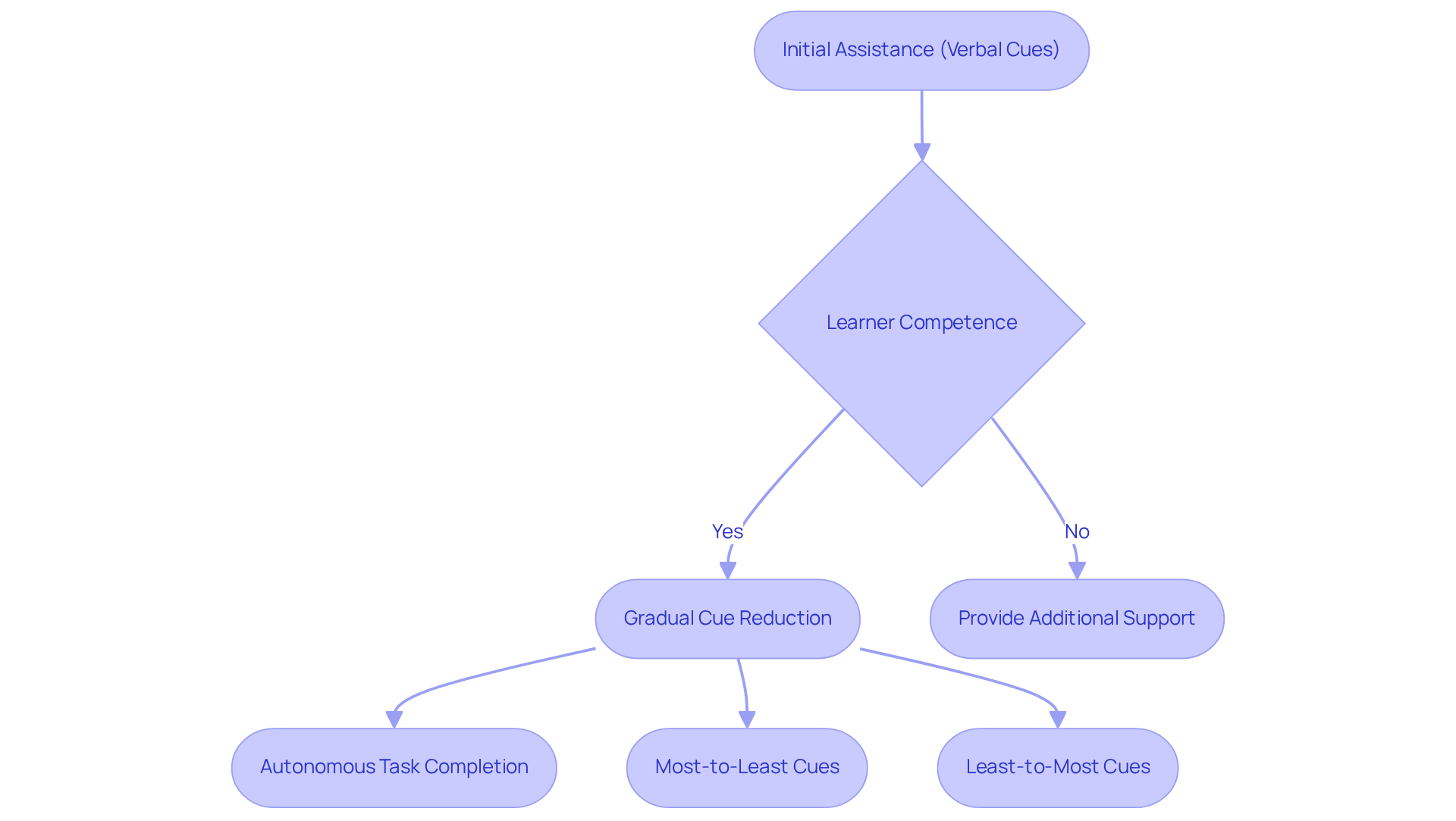
Delayed prompting involves waiting a specified duration before delivering a cue after a question or task is presented. This method not only encourages learners to think independently but also significantly enhances their . For example, a BCBA may ask a child to identify an object and then pause for a few seconds before offering a hint. This brief wait allows the child the crucial opportunity to recall the information autonomously, thereby fostering greater cognitive development.

Stimulus fading is a critical technique that involves progressively modifying the features of a cue, thereby reducing its intrusiveness while still effectively guiding the learner. For example, when a BCBA employs a colored card to prompt a child's response, they may gradually change the card's color to a more neutral shade, ultimately leading to its complete removal. This strategic approach not only facilitates learning but also serves as that encourage clients to respond to their natural environment, rather than depending solely on artificial cues.
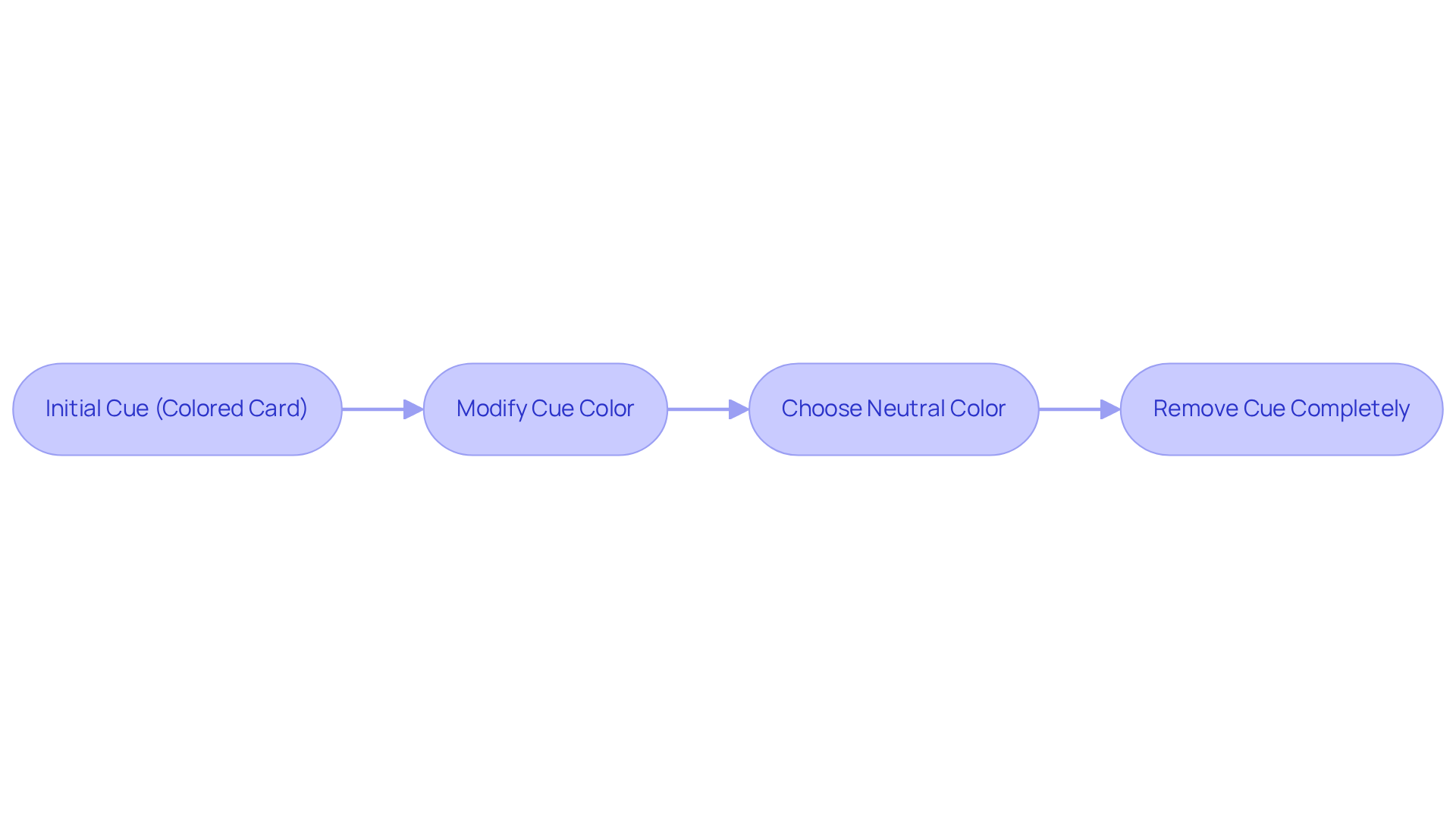
Stimulus control examples illustrate that stimulus prompting is a critical technique that employs specific cues to elicit desired behaviors. These cues—whether visual, auditory, or tactile—serve as stimulus control examples that are strategically designed to guide the learner toward the correct response.
For instance, consider the scenario where a Board Certified Behavior Analyst (BCBA) utilizes a visual schedule to encourage a child to follow a sequence of activities. This method not only promotes structured learning but also reinforces the behavior through positive reinforcement, rewarding the child each time they successfully complete a step.
This approach provides stimulus control examples that illustrate the effectiveness of targeted cues in behavior modification.

Prompt dependency, generalization issues, and inconsistent reinforcement present significant challenges in stimulus control examples during ABA therapy. Did you know that dependency rates among ABA clients can soar as high as 70%? This alarming statistic underscores the urgent need for effective strategies, such as stimulus control examples, to reduce reliance on cues. When students become excessively , their capacity to respond to natural signals diminishes, hindering their progress toward autonomy.
Board Certified Behavior Analysts (BCBAs) can tackle this issue by systematically decreasing cues and gradually lessening support to promote self-initiation. As one BCBA insightfully noted, "By systematically reducing cues, learners become less dependent on external signals, thereby enhancing their confidence and self-efficacy." Providing stimulus control examples is equally crucial for ensuring consistent reinforcement across various settings to promote skill generalization.
Successful strategies, such as stimulus control examples like implementing a least-to-most prompting approach, provide minimal assistance initially, escalating only as necessary. This method not only encourages independence but also bolsters learner confidence. For instance, a compelling case study illustrated that a child who initially required full physical prompts successfully completed tasks independently after a structured prompt fading plan was implemented.
Regular monitoring and flexibility in applying these strategies are essential to adapt to each learner's unique needs. Ultimately, this adaptability enhances their ability to engage independently in their environments. Are you ready to explore how to implement these strategies effectively in your practice?

The effects of incentive management transfer significantly influence clients' everyday lives, affecting their social interactions, academic achievement, and overall quality of life. For instance, effective cue management transfer can lead to a remarkable 30% increase in the generalization of acquired skills when caregivers actively engage in reinforcement methods. Board Certified Behavior Analysts (BCBAs) must prioritize the generalization of skills learned in therapy across various settings, including home, school, and community environments. This strategic approach ensures that clients can adeptly navigate diverse situations, thereby enhancing their independence and adaptability.
Practical applications of support transfer have demonstrated that children can autonomously request items using AAC devices after initial assistance is diminished, showcasing the effectiveness of these methods in improving functional communication. Furthermore, research indicates that 100% of participants achieved accurate responses when appropriate consequences were implemented during the transfer of oversight, underscoring the critical role of organized reinforcement in facilitating skill acquisition.
Additionally, the optimal rate of reward for binary classification learning has been identified as approximately 85%, emphasizing the importance of reinforcement strategies in ABA therapy. Ultimately, the successful implementation of reinforcement management transfer not only fosters improved social interactions but also , establishing it as a vital component of effective ABA therapy.
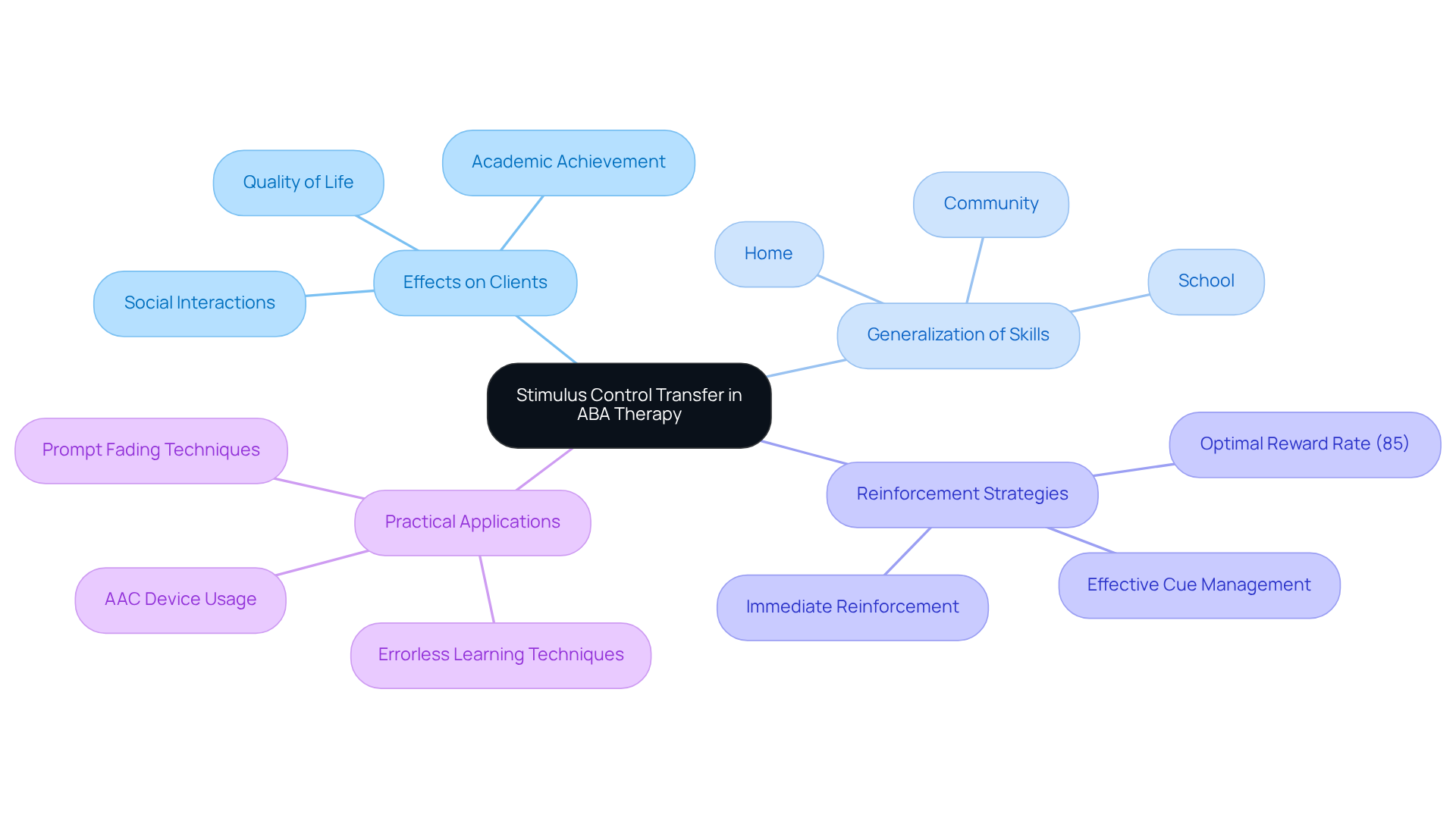
Advancements in ABA therapy, particularly technology-assisted interventions and data-driven methods, are significantly transforming response transfer techniques. The use of applications and programs facilitates progress monitoring and provides immediate feedback. This capability empowers behavior analysts to adjust strategies as necessary. For practitioners, staying informed about these advancements is not just beneficial; it is essential for and improving client outcomes.
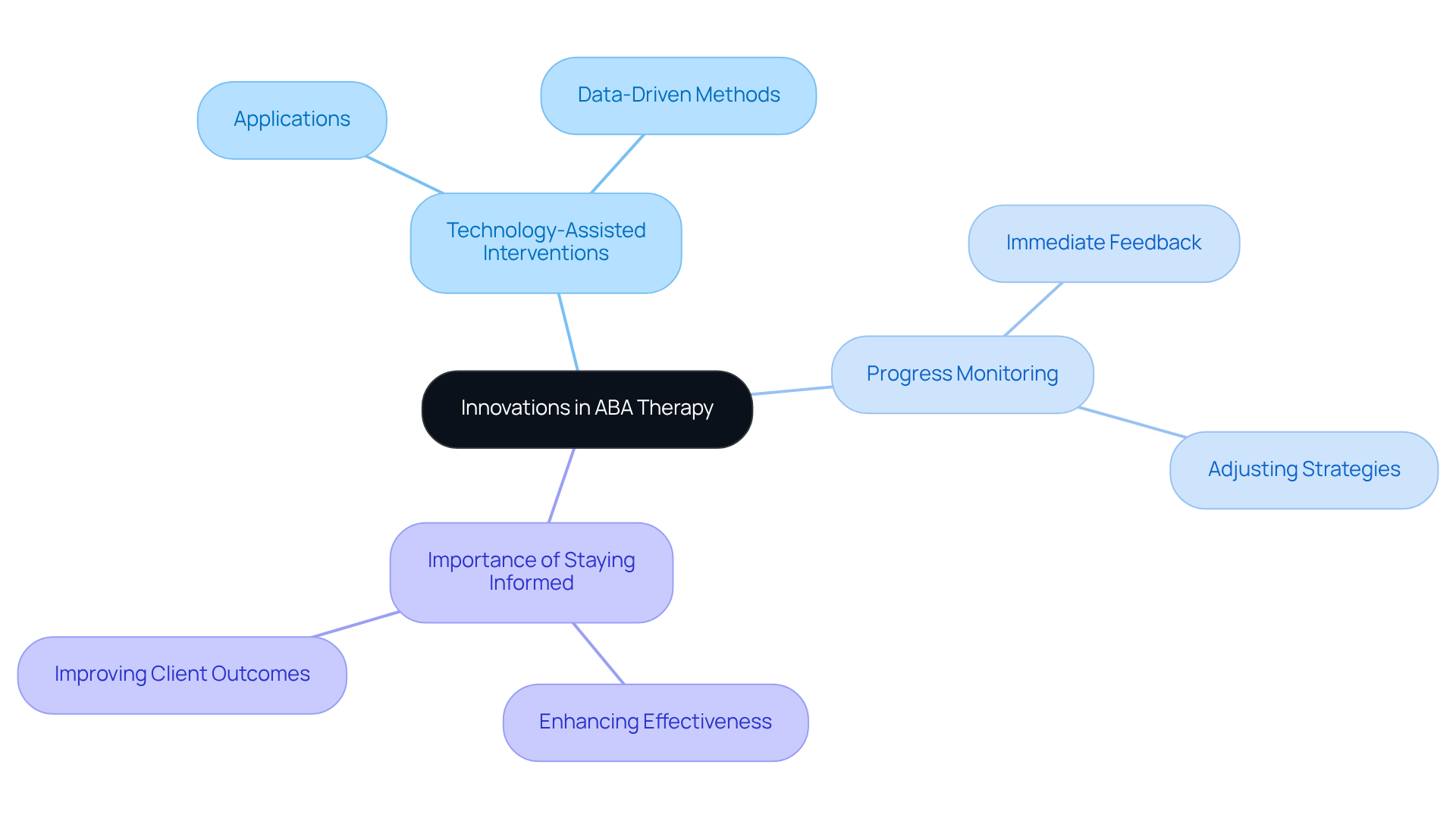
The foundations of response regulation are fundamentally rooted in behaviorism, which meticulously investigates the intricate relationship between signals and reactions. Central to this framework are key concepts such as reinforcement, discrimination, and generalization. Understanding these principles is crucial for Board Certified Behavior Analysts (BCBAs) as they develop and implement that foster learning and facilitate behavior change.
For instance, strengthening a specific reaction in the presence of a particular cue can serve as stimulus control examples that significantly enhance cue management, leading to more predictable and favorable behaviors. Research indicates that programs emphasizing robust response management procedures yield 40% improved generalization results compared to those that do not explicitly instruct on discriminative responding. Furthermore, programs incorporating evidence-based intervention methods demonstrate 45% improved long-term outcomes in comparison to those employing less systematic strategies.
Interventions focusing on reinforcement strategies can reduce inappropriate behaviors by up to 70% while simultaneously promoting appropriate alternatives. Recent research underscores the efficacy of these strategies in establishing strong response management, highlighting the importance for BCBAs to integrate these concepts into their practice for optimal therapeutic results.
As articulated by the Behavior Analyst Certification Board (BACB), stimulus control examples are evident when a behavior occurs more frequently in the presence of a specific cue (known as the discriminative cue or SD) and less often when it is absent. Additionally, a 2019 study revealed that children in ABA programs concentrating on cue discrimination acquired target skills 60% more rapidly than those in comparison groups.
It is essential for behavior analysts to consider cultural factors when applying programming for managing responses to ensure that interventions are effective and relevant to diverse populations.
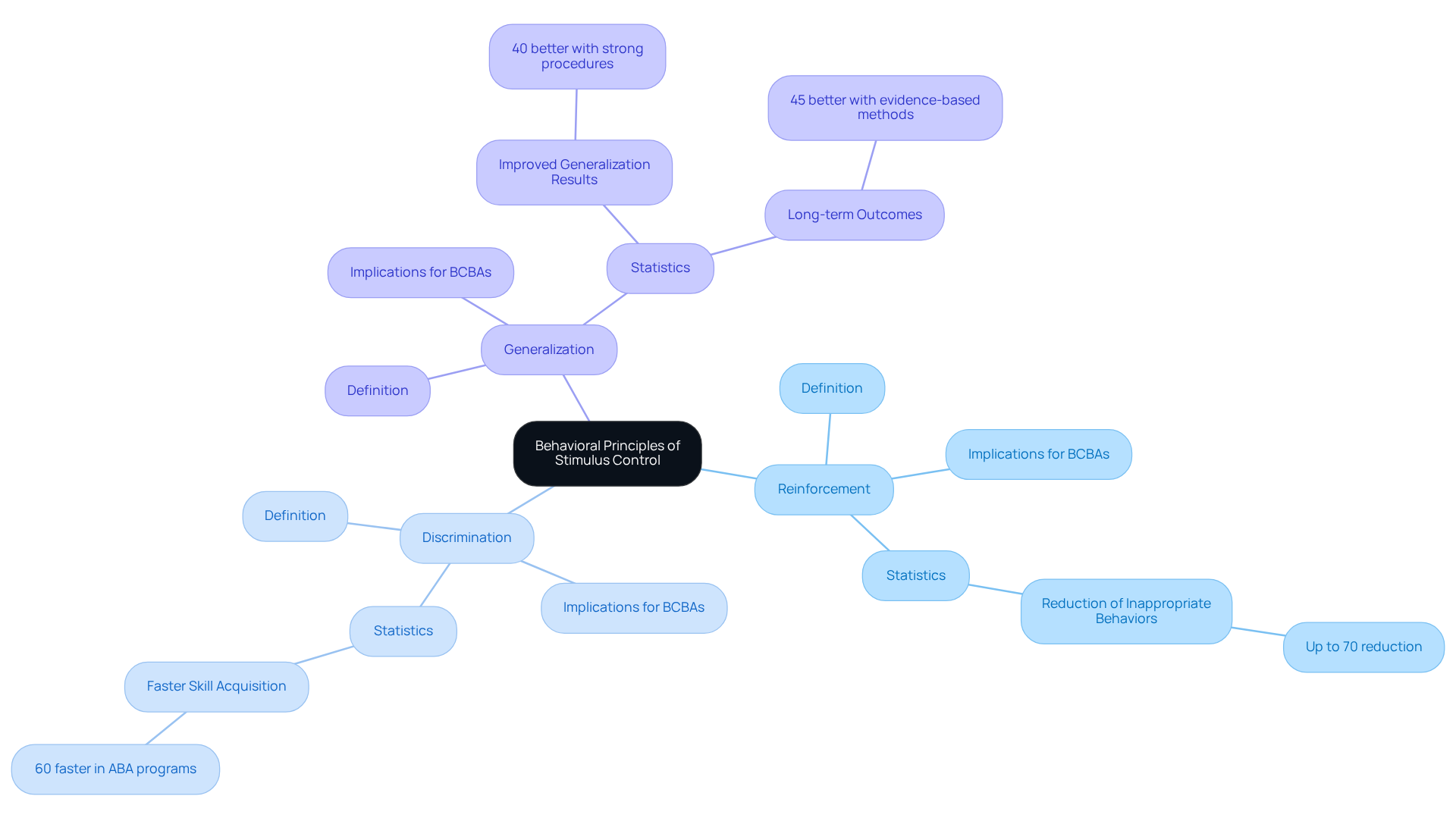
Evaluating the effectiveness of stimulus control examples is crucial for ensuring . Systematic data collection and analysis are essential in this process. BCBAs must track client progress meticulously, noting improvements in independent behavior and generalization across various settings.
Regular assessments not only allow practitioners to identify areas for improvement but also enable them to adjust their strategies accordingly. This ongoing evaluation ensures that clients receive the most effective interventions possible.
Are you leveraging your data effectively to enhance client outcomes?

The exploration of stimulus control techniques in ABA therapy reveals their critical role in fostering independence among learners. By implementing strategies such as prompt fading, delayed prompting, and stimulus fading, behavior analysts can effectively reduce reliance on cues and empower individuals to respond to natural signals in their environment. This shift not only enhances skill acquisition but also nurtures self-confidence, ultimately leading to improved outcomes in various settings.
Throughout the article, key insights were presented, including:
Real-world applications demonstrate that when these techniques are employed thoughtfully, clients experience significant gains in their ability to navigate daily challenges autonomously. Furthermore, the incorporation of technology-driven methods offers exciting possibilities for monitoring progress and refining interventions.
As the demand for Board Certified Behavior Analysts continues to rise, embracing these innovative strategies will be essential for practitioners aiming to enhance their effectiveness. The implications of stimulus control transfer extend beyond therapy sessions, impacting clients' social interactions, academic success, and overall quality of life. By prioritizing these techniques, behavior analysts can create a more supportive environment that fosters independence and enriches the lives of those they serve.
What is Hire ABA?
Hire ABA is a specialized recruitment platform designed to streamline the job search for Board Certified Behavior Analysts (BCBAs), connecting candidates with roles that match their skills and career aspirations.
Why is there a growing demand for BCBAs?
The demand for Board Certified Behavior Analysts is projected to increase by 25% by 2026, creating an urgent need for effective recruitment strategies in the healthcare sector.
How does Hire ABA enhance the hiring process?
Hire ABA enhances hiring efficiency by offering personalized resume assessments and advanced job fit scoring, which evaluate candidates' experiences and career goals to match them with suitable job opportunities.
What tools does Hire ABA provide for employers?
Hire ABA provides tools that help healthcare employers optimize their recruitment strategies, allowing them to quickly identify qualified BCBAs to meet the increasing market demand.
What is prompt fading in behavior analysis?
Prompt fading is a technique that involves the systematic reduction of assistance provided to learners, enabling them to perform desired behaviors independently and respond to natural environmental signals.
What are the benefits of gradual fading?
Gradual fading leads to significant enhancements in skill acquisition and retention, reducing cue dependency and fostering autonomy and self-confidence in learners.
What are Most-to-Least (MTL) and Least-to-Most (LTM) cue strategies?
MTL cues start with the most intrusive signals and progressively reduce support, while LTM cues begin with minimal assistance and increase support as needed, allowing for customized support for each learner.
How can cue fading be applied in practice?
Case studies show that caregivers and educators can effectively use prompting techniques to guide children through new skills, resulting in enhanced independence and skill generalization.
What role do BCBAs play in cue fading?
BCBAs emphasize the importance of structured fading approaches and consistent communication among caregivers, educators, and therapists to monitor student progress and reduce dependency on cues.
What is delayed prompting?
Delayed prompting involves waiting a specified duration before delivering a cue after a task is presented, encouraging learners to think independently and enhancing their cognitive skills.
Our expert recruitment strategies and AI-driven sourcing ensure that you receive top-notch candidates quickly, without compromising on quality. Whether you’re looking for BCBAs, Clinical Directors, or RBTs, we’ve got you covered.